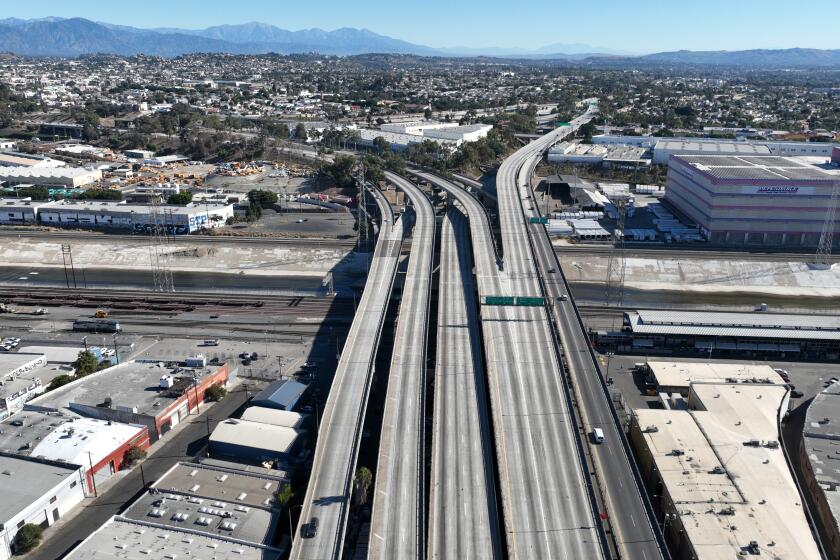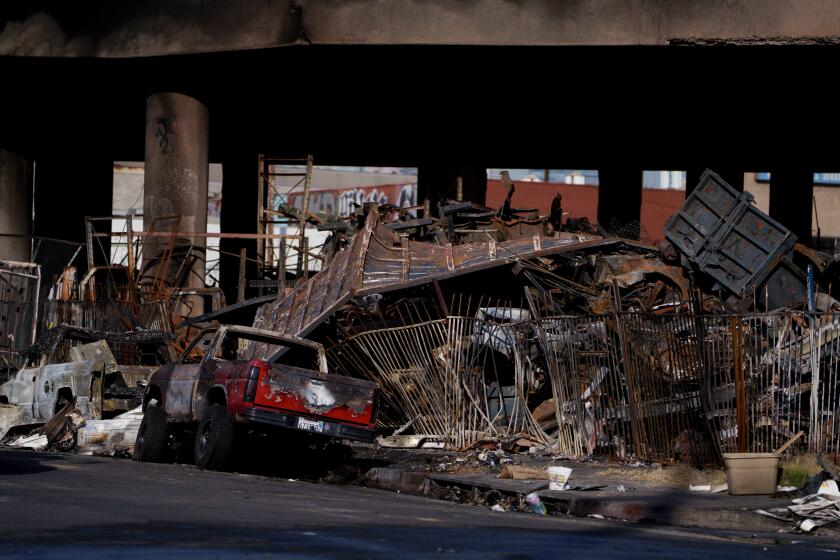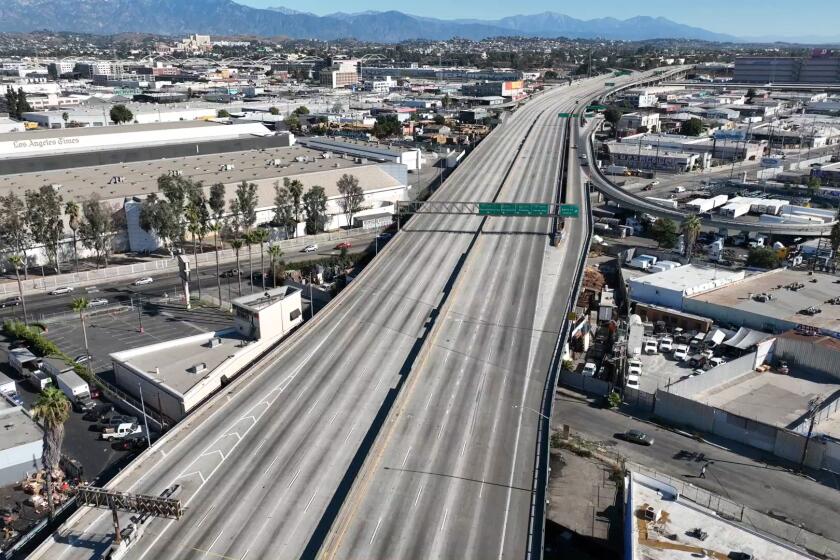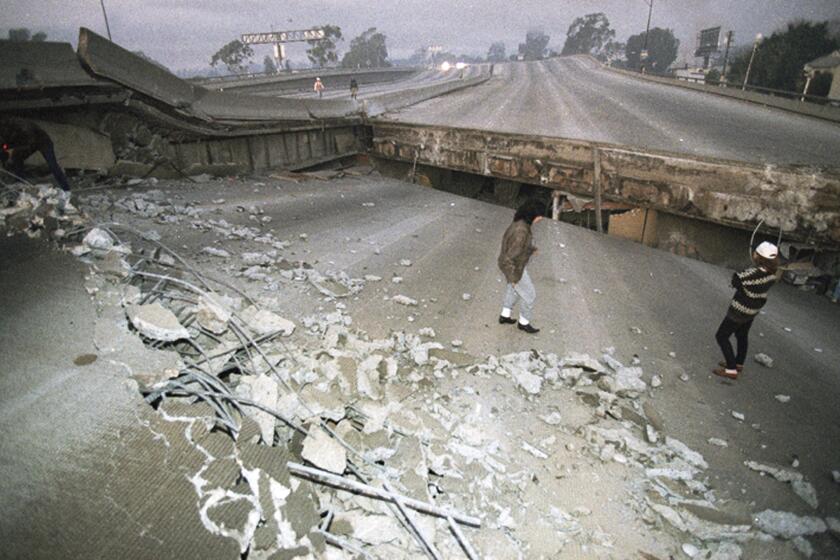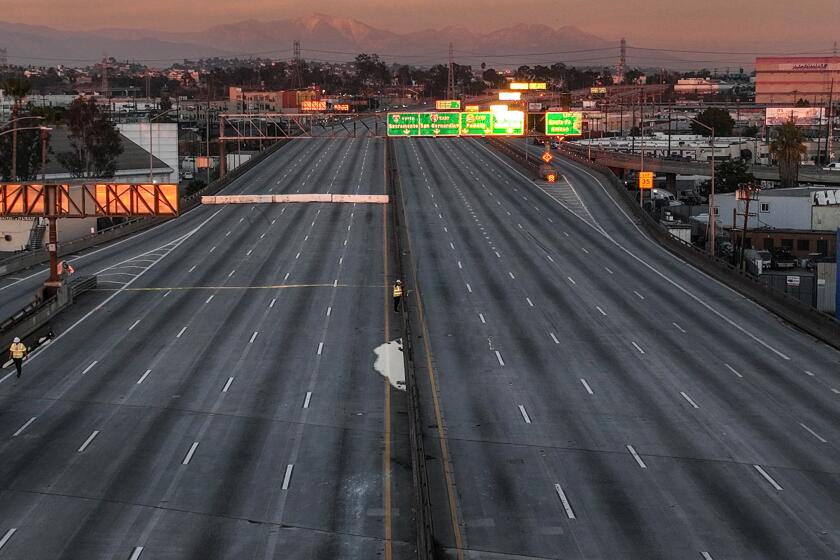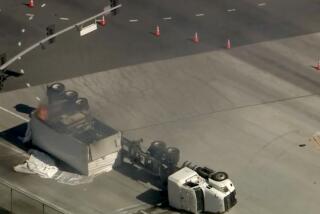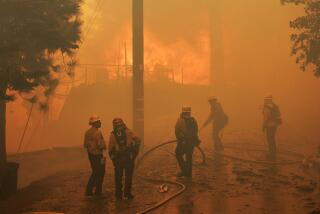Section of 10 Freeway damaged by fire will not need to be demolished, officials say
A section of the 10 Freeway in downtown Los Angeles that was damaged by a massive fire over the weekend will not need to be demolished, officials announced Tuesday, but repairs could take weeks, complicating commutes through one of the country’s busiest freeway corridors.
“This is not a demo operation. This is a repair operation,” Gov. Gavin Newsom said Tuesday morning at the site of the fire, which started under the overpass at Alameda Street early Saturday.
Core samples taken from the freeway columns and bridge deck showed that damage from the pallet-fueled fire was not as extensive as it could have been in a worst-case scenario. Though a teardown will not be necessary, repair work will take three to five weeks, and traffic lanes could be partially reopened during construction, Newsom said.
“I want to see something much faster,” Newsom added. “And I have all the confidence in the world of the men and women you see behind me and the pace of their repairs already underway.”
Officials are “setting long expectations” with the timeline announced Tuesday, according to a bridge engineer with the California Department of Transportation who was not authorized to speak publicly and requested anonymity, adding that crews working on the scene “will deliver early.”
A crucial stretch of the 10 Freeway remains closed through downtown L.A. after a major fire damaged the highway. Here is what we know.
More than 100 columns along the swath of the freeway were damaged — nine or 10 of them severely — Newsom said. Construction crews have erected wooden structures to shore up the overpass while the repair work gets underway.
Preliminary tests showed that damage from Saturday’s massive fire is not as severe as initially feared, according to the Caltrans bridge engineer who spoke to The Times.
Caltrans engineers met with senior management Monday to provide an assessment of the damage and possible timelines for getting traffic moving again across the mile-long section of the 10 between Alameda Street and the East L.A interchange, a heavily trafficked east-west route through downtown.
“The results were very good,” said the engineer, who described two scenarios contingent on the damaged freeway being shored up and supported from underneath.
In the worst case, the shoring will be removed in stages — on the eastbound or westbound side, then the other — so lanes can be replaced and portions of the road can be kept open to traffic heading both directions. In the best-case scenario, which the engineer said appears likely, the shoring will stay in place so that all lanes are safe to use while the repairs are made.
It remains unclear when traffic will first be allowed back onto the freeway, which the engineer said is contingent on final test results expected by the end of the week.
A Caltrans spokesperson declined to comment on the engineer’s statements.
The fire, which arson investigators believe was intentionally set, started at a property under the 10 that was being leased from Caltrans by Apex Development Inc., a Calabasas company that Newsom said had stopped paying rent and was subleasing the site without permission from state and federal agencies. The blaze burned through wood pallets being stored there.
In 2017, a similar fire caused a portion of Interstate 85 in Atlanta to collapse after combustible materials stored under the interstate caught fire. The closure snarled commuter traffic for six weeks, after which Caltrans wrote a policy directive directly based on that incident that prohibited the storage of flammable materials under its bridges and required access for bridge inspections.
“Caltrans has known about this for a long time,” the engineer said. “They have permitted lessees to store flammable stuff underneath these freeways for decades. They’ve had a couple of fires in the last three years that have affected columns, but inspectors can’t completely get underneath the bridge to make a thorough inspection because of all the junk.”
A Caltrans engineer said he expects the best case in getting the 10 Freeway through downtown Los Angeles open as soon as possible. Luckily, the fire didn’t lead to more severe damage.
As traffic-hardened Los Angeles adjusted to the new reality of a severed 10 Freeway, officials said they saw encouraging signs and a reminder of the challenges to come from Monday’s first test of the detours.
“The morning commute, while congested, did not result in gridlocked streets,” Laura Rubio-Cornejo, general manager of the Los Angeles Department of Transportation, said during Tuesday’s news conference.
The lack of congestion seemed to suggest that residents had heeded the numerous cellphone alerts, social media posts and messages from city officials asking them to avoid driving through the area and find other ways of getting to their destinations.
Though the evening commute saw a “higher degree” of congestion on the streets being used to reroute traffic from the 10, Rubio-Cornejo said traffic engineers adjusted light patterns to mitigate the problems.
Overall, officials said, the downtown streets being used for detours saw a 14.7% increase Monday over normal daily traffic. That seemed to be a “manageable” increase, Rubio-Cornejo said, but she warned that even slight increases in traffic downtown could have a cascading effect not just on the detour routes but also on connected streets and communities.
There is no timeline for when the freeway will be reopened, but officials say the work will not happen swiftly.
“It is important to remember that these are typically some of the most utilized and congested streets under normal circumstances,” she said. “For every percentage increase, the effect is even greater and congestion spreads wider.”
Though many L.A. Unified students are now taking buses to school “within the realm of a new crisis,” Supt. Alberto Carvalho said at a Monday news conference, delays were not significant. About 42 of the district’s 1,300 bus routes were affected, with delays averaging 10 to 15 minutes.
To help relieve congestion, a spokesperson for LADOT said the Commuter Express bus service will be free; its buses head directly downtown from areas such as the northeast San Fernando Valley, Thousand Oaks, the South Bay, Long Beach and others. Metrolink, the regional rail service, is adding trips between Covina and Union Station, and increasing the number of cars on its San Bernardino Line.
During the closure, commuters should take public transportation, avoid the area if possible and follow navigation apps so they do not clog surface streets, officials said.
“Angelenos, it’s good news,” Mayor Karen Bass said at Tuesday’s news conference with state and local officials. “Instead of months, we are talking about weeks, as the governor mentioned. But it’s still three to five weeks in Los Angeles for this freeway not to be in operation.”
Bass referenced the damage caused by the 1994 Northridge earthquake that knocked out two freeway bridges on the 10 at La Cienega and Washington boulevards, cutting off a key traffic corridor.
The collapsed freeway section was rebuilt and opened to traffic about three months after the 1994 Northridge earthquake knocked it down. The crucial freeway corridor is once again closed, this time due to a fire.
Round-the-clock repairs got the freeway reopened in less than three months — in what officials described as record time, giving L.A.’s quake recovery an important boost.
“Something that we didn’t have in 1994 is public transportation,” Bass said. “We didn’t have the technology that we have today. So there’s no reason for this to be the disaster.”
Several days after the fire, the Los Angeles Fire Department responded to three smaller fires near other freeways in the region.
At 6:58 a.m. Tuesday, firefighters received multiple calls reporting a vegetation fire at West 98th and South Flower streets, along the 110 Freeway. Shortly after, the department responded to another vegetation fire on Figueroa and 117th streets, adjacent to the interchange of the 110 and 105 freeways.
It’s not as though L.A. freeways were a joy to drive before fire closed a section of the 10 Freeway, but commuters will have to adapt to a potentially weeks-long disruption.
Both fires were quickly contained, according to Fire Department spokesman Brian Humphrey.
Another fire reported near the Hoover Street onramp to the 105 was extinguished in about 30 minutes.
Humphrey said he was not aware of any connections between the fires.
The smaller blazes were nowhere near the scope that forced the closure of the 10, he said, noting that they burned near residential areas, making it a good time for residents to survey the exterior of their homes for potential fire fuels such as weeds, debris, lumber piles or cardboard boxes.
“Whether the fire is wind driven, suspicious or intentional, no neighborhood is exempt,” Humphrey said.
More to Read
Sign up for Essential California
The most important California stories and recommendations in your inbox every morning.
You may occasionally receive promotional content from the Los Angeles Times.
